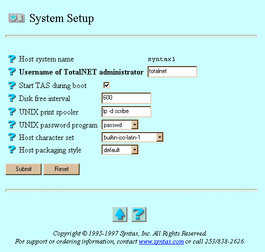4.1.4 Updating System Configuration
Follow these steps to change system configuration attributes:
-
Follow these links:
-
System->System Administration->System Setup
The System Setup screen appears:

-
-
Enter or select values for the following attributes, as needed:
-
Username of TotalNET administrator -- The UNIX name of the TAS administrator. The TAS administrator must own the TAS home directory. This attribute defaults to totalnet.
-
Start TAS during boot -- The option to cause TAS processes to start when the operating system starts.
-
Disk free interval -- The number of seconds you wish to pass between recalculations of free disk space by the TNdiskfree program. This attribute defaults to 600 seconds--one recalculation every 10 minutes.
-
UNIX print spooler -- If the UNIX system has more than one spooler installed, the full path name of the UNIX print spooler program you want to use.
-
UNIX password program -- The UNIX program for changing users' UNIX passwords. If your system uses NIS, select yppasswd; if it uses NIS+, select nispasswd; if it uses neither, select passwd.
-
Host character set -- Part of the scheme for mapping file names across realms. This attribute designates the name of the character set used by the host. It defaults to builtin-iso-latin-1--the built-in version of the ISO-8859-1 character set, a superset of ASCII.
-
Host packaging style -- The field that designates the way TAS puts together, within a byte-stream, the character set used by the host. Select one of the following: default to indicate that the Host character set value determines the packaging style, single if the host character set contains only one-byte characters, euc if it contains one-, two- and three-byte characters, shift-jis if it contains only one- and two-byte characters.
-
-
Click Submit.
The Updating System Setup screen appears.
-
Click OK.
To update system configuration from the UNIX command line, use the tnsystem command.
- © 2010, Oracle Corporation and/or its affiliates
